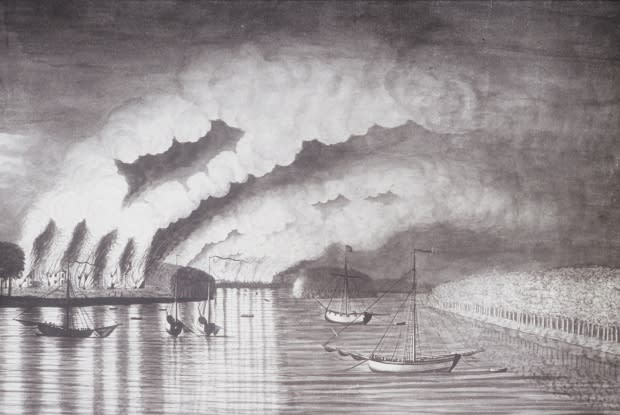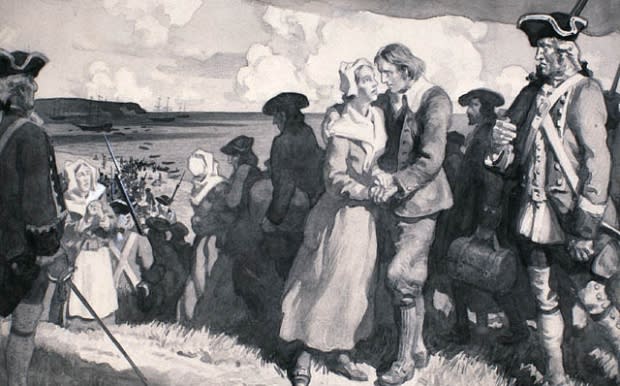Massacre of Acadians 'forgotten' aspect of Fredericton's history
A dark moment in Fredericton history took place 260 years ago this year.
The destruction of Pointe-Sainte-Anne, an Acadian settlement in modern-day Fredericton, by the British army is a somewhat forgotten piece of the capital's history.
"I don't think Frederictonians know much about this," said Chantal Richard, a French studies professor at the University of New Brunswick. She is the curator of an upcoming exhibit on the settlement at the Fredericton Regional Museum.
Stephane Pettigrew, a PhD candidate at UNB, said she's been interested in the settlement since she arrived in Fredericton in 2013, especially since it's not well known.
"I always found it interesting that there was very little that showed the history of Acadians in the area," said Pettigrew. "There's almost no focus on it whatsoever except for the name of the school [École Sainte-Anne]."
The community
The Acadians had been present in the Fredericton area since 1692, when the French constructed Fort St. Joseph, also known as Fort Nashwaak, on the city's north side.
While it's difficult to say how many people lived in Pointe-Sainte-Anne, a 1739 census lists 86 people living in the area.
"Now in terms of area, we have several reports that seemed to corroborate the idea that about 500-to-600 acres were being used by the inhabitants of Pointe-Sainte-Anne," said Richard.
The settlement is believed to have been located where the downtown is now.

The residents lived an agrarian lifestyle. Other than farms, it is known that a church existed in the settlement.
However, there is not much archeological evidence to show where these structures stood.
"There have been numerous excavations in the area around Old Government House and they have found some evidence of Acadian occupation," said Richard.
"There is part of an Acadian cellar that was found. However, there has been so much development and disruption in the soil since the settlement was destroyed in 1759 that it's very difficult now to find anything that would confirm where the specific buildings would have been located."
The expulsion
The event that has come to be known as the Expulsion of the Acadians took place in Acadia during the French and Indian War, which was what the British named the North American portion of the Seven Years' War.
The expulsion saw the forced removal of Acadians, starting first in modern-day Nova Scotia.
Some of the Acadians were sent to England or France, eventually settling in Louisiana, or French colonies in the Caribbean, but others moved further inland in Acadia.

"A lot of Acadians managed to avoid actually getting deported and instead of getting on the boats in Grand Pré or other places along the Bay of Fundy they actually fled into present day New Brunswick," said Pettigrew.
"A lot of that fleeing, because it was easier to transport yourself up waterways than on foot, happened up the St. John River."
This meant the population of Pointe-Sainte-Anne likely grew.
St. John River Campaign
As the Acadians moved further inland, so did the British.
Robert Monckton, the British military figure Moncton is named for, moved troops up the St. John River, forcing Acadians further into retreat.

One of the better known moments of the early campaign was Monckton's burning of Grimross, modern-day Gagetown, in October 1758.
However, shortly after arriving in Maugerville, Monckton, fearing the the onset of winter, turned back to Fort Frederick, modern-day Saint John.
"He sent a few men upriver and they came back and essentially Monckton assessed the settlement of Pointe-Sainte-Anne as being a small settlement without any fortifications. And so he chose not to keep going upriver," said Richard.
Brutal massacre
In February 1759, Colonial lieutenant Moses Hazen travelled with a troop of New England Rangers to Pointe-Sainte-Anne.
At Pointe-Sainte-Anne, Hazen burned 147 buildings and killed numerous Acadians.
"It's considered to be one of the most brutal massacres of the expulsion period by several historians, but also even at the time," said Richard.
"Once the news got to Monckton, and also General Amherst, they disapproved of Hazen's actions because he killed women and children, and scalped a few women and children as well."
Joseph Godin
Joseph Godin was a farmer and lived in Pointe-Sainte-Anne with his family.
He claimed to be the first Acadian born in Pointe-Sainte-Anne and provided one of the few first-hand accounts of the massacre.
He described to a writer his experiences there.
"They carried the rage to massacre his daughter Nastazie, wife of Eustache Paré, crushed her two son's heads with rifle butts and a son of Michel's," it was written about his experience.
"They cut off the head of the man's wife with an axe. During the barbaric scene Anne Bergeron and Eustache Paré, her son-in-law, each took in their arms a child and saved them from the fury of these cruel men by fleeing in the woods with what they were wearing, without having time to grab clothing, supplies or papers."
He would be sent to England with his wife, before finally settling in France.
The survivors
Some escaped the massacre. Many went upriver to the Madawaska area or to Beaubears Island in Miramichi.
Some families remained in the Fredericton area, like the Mazerolle, Martin and Godin (later named Goodine) families.
'It's considered to be one of the most brutal massacres of the expulsion period.' - Chantal Richard
Richard said after the Seven Years' War, and the Treaty of Paris, persecution of Acadians was reduced but never truly went away.
Some Acadians received some land grants in the Douglas area.
"There are some accusations of continued harassment and persecution on the part of Acadians who eventually abandoned the area again because … they didn't feel welcome in the area," said Richard.
Forgotten history
The destruction of Pointe-Sainte-Anne is a part of history that has largely been forgotten by Frederictonians.
Richard believes one explanation for this may be the influence of the loyalists in the area.
She said regions have a "collective identity" and Fredericton's identity is overwhelmingly related to the loyalists.
"I think that the identity of Fredericton as a city has long been built around a more of a loyalist identity or an anglophone identity," said Richard.
"Therefore this part of history that predates the arrival of the loyalists has been a little bit forgotten."

